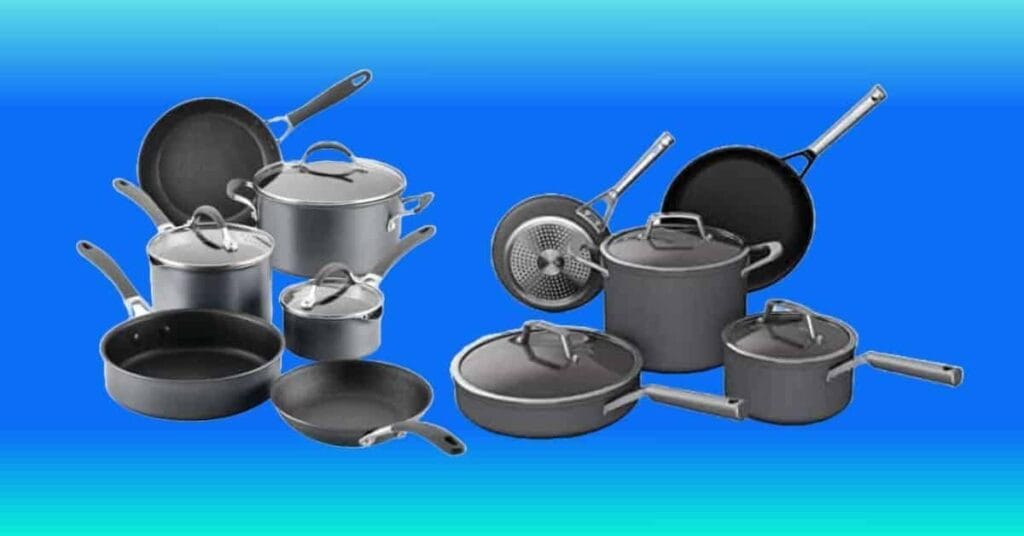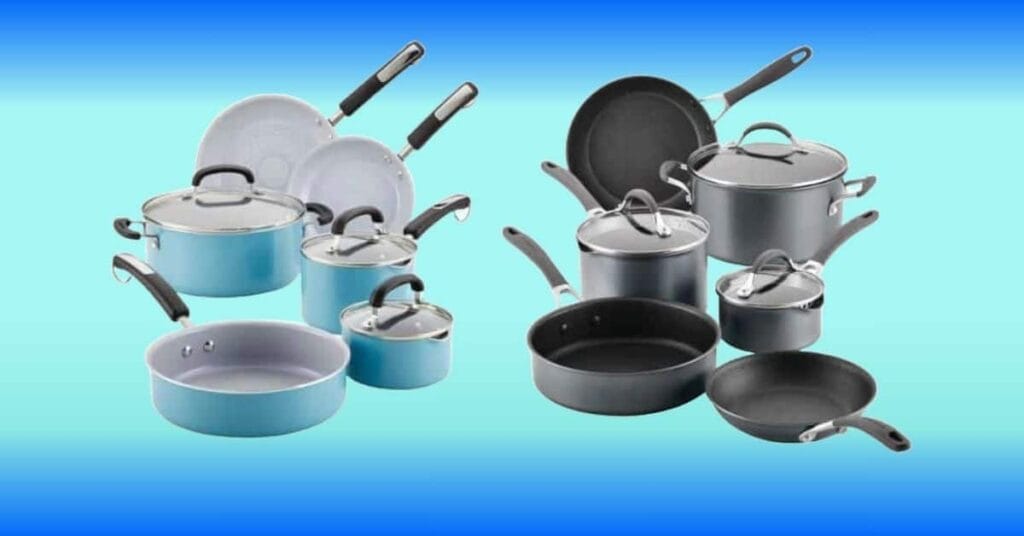Carbon steel pans widely tested cookware, proved smooth, naturally non-stick, and versatile for baking, frying, searing, and even in boiling works.
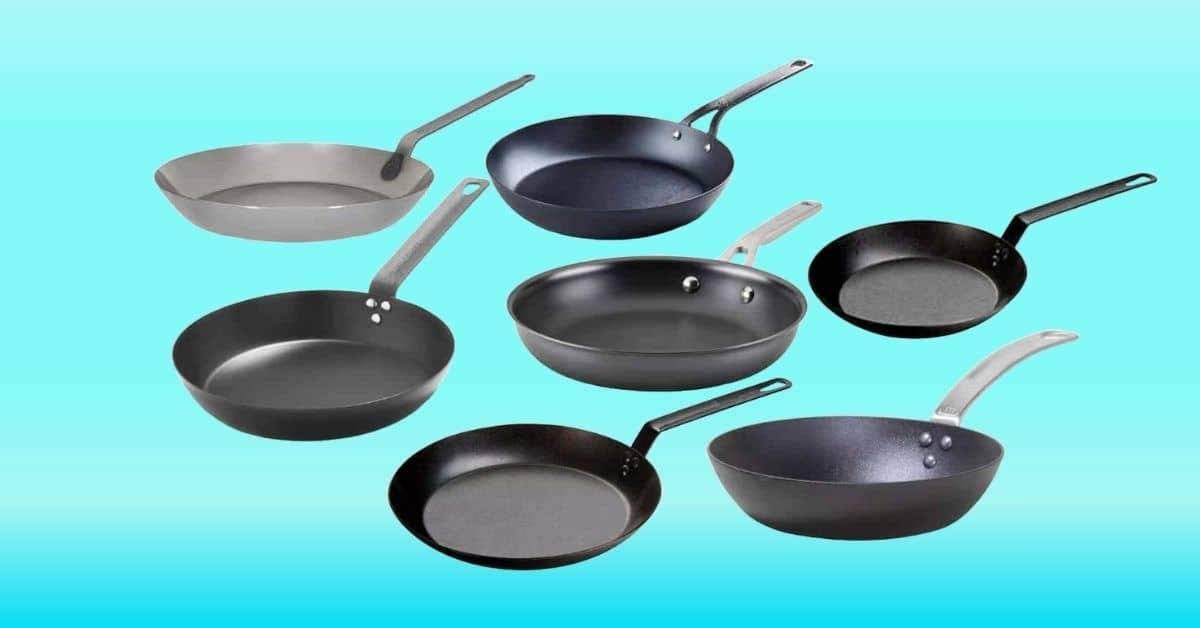
The best carbon steel pan is the one that fits your kitchen habits and long-term cooking goals. Carbon steel is similar to cast iron and therefore deserves a place in your kitchen, so the sooner you think about buying a carbon steel pan, the better. Mauviel was our best overall carbon steel pan. This lightweight skillet was easy to release food from and it was also pleasant to use. This OXO pan was also a favorite of ours as a more affordable choice; it was incredibly non-stick.
Cast iron skillets have long been a staple in any kitchen, but carbon steel pans made from another metal are now popular with professional chefs around the world. These pans are made of a mixture of carbon and iron; they’re similar to cast iron and are thinner, lighter, and more sensitive to temperature changes. Such as cast iron, a majority of carbon steel pans must be seasoned before reaching their natural nonstick potential, although some are marketed as already seasoned, and it is worth mentioning that, in either case, carbon steellike cast iron will never be as non-stick as Teflon.
We like carbon steel pan because after it has been seasoned, it will provide you with a nonstick surface that will be equal to metal cooking tools, which means that you do not have to worry about scratches. Carbon steel pans are compatible with gas, electric, induction cooktops, and even open fires if that is your preference. Durability of carbon steel pans is also another appealing feature. These pans are capable of withstanding extremely high temperatures for hours and can be moved between the stove and the oven without any problems.
Deciding on the best carbon steel pans comes down to matching the pan’s features with your cooking style and needs. If you cook small meals or eggs, an 8–10 inch pan works best, while a 12 inch option is more versatile for family dishes. Thicker pans retain heat well for searing meats, whereas thinner pans heat quickly and are easier to handle. Pre-seasoned pans are beginner-friendly, while raw pans offer more control over seasoning. Handle comfort, weight, and budget also matter.
Carbon steel pans should not be used with acidic sauces for long periods of time as this will corrode their seasoning (like cast iron). We found the best-rated carbon steel pans and then tested their design, heating capacity, ease of cleaning, etc. to see which one would be ideal to add to your cookware collection.
Top Picks of the Carbon Steel Pans
1
Best Overall Carbon Steel Pan
Made In Blue Carbon Steel Frying Pan
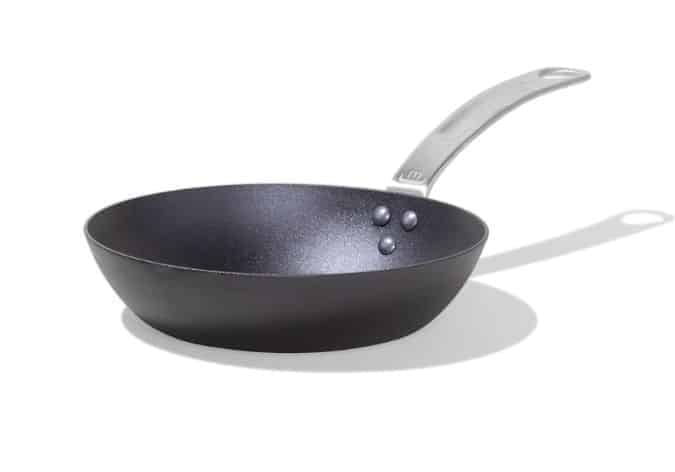
PROS
- Sloped sides allow for easy flipping
- Deep design is perfect for pan-frying
- Heats quickly with even distribution
CONS
- Seasoning begins light a bit
The Made In company is establishing itself as a brand of quality kitchenware, and there is no wonder that its blue carbon steel frying pan is a popular one. The blue color is noticeable when the pan comes, but it changes to darker as it is seasoned and used frequently, as it should. The sloped sides make it easy to flip the food and the arched handle gives it a steady and balanced grip. The pan can also be hung on a hook easily with a hole in the handle.
During testing, we found that the pan was spotty in its first seasoning, but that the quality of the nonstick improved with subsequent use and seasoning between cooking sessions. It warmed fast and evenly, and it gave a fantastic sear to steak. Like any other carbon steel pan, it needs a bit of maintenance, but it can be wiped down with a paper towel.
Size: 10 inches | Weight: 3 pounds | Oven-Safe Temperature: Up to 1200°F | Pre-Seasoned: No
2
Best Value Carbon Steel Pan
Lodge Preseasoned Carbon Steel Skillet
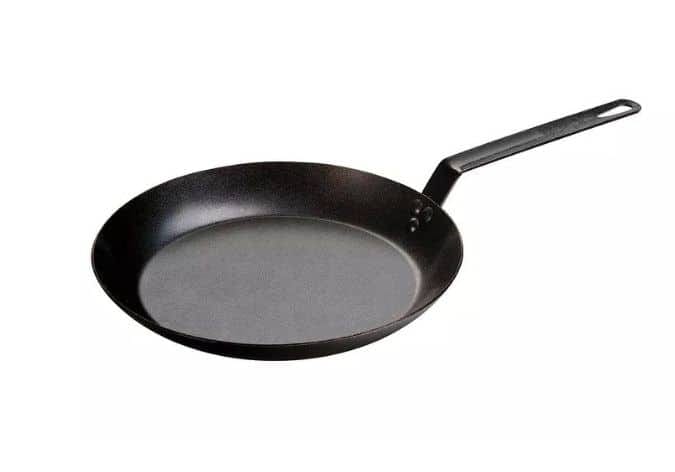
PROS
- Worked great for frying steak and eggs.
- Suitable for stovetop, oven, grill, and campfire use
CONS
- Sides are slightly shallower than other skillets on our list
Lodge is famous in its dependable cast iron pans, and this carbon steel skillet is maintaining the reputation of the brand with regards to good cookwares. At under forty dollars, the skillet is a steal as it performed well in our tests, is preseasoned and fits all cookstoves, in addition to campfire cooking.
The sides are shallower than those of other pans we tested, which somewhat restricts capacity and can make it more difficult to toss ingredients. However, its long handle and sturdy build provide a balanced feel for shaking or stirring. It also made a good impression during the tests, as it made a rich, tasting pan sauce within a short period of time.
Size: 10 inches | Weight: 3.1 pounds | Oven-Safe Temperature: Up to 500°F | Pre-Seasoned: Yes
3
Best Runner-Up Carbon Steel Pan
Matfer Bourgeat Black Carbon Steel Fry Pan
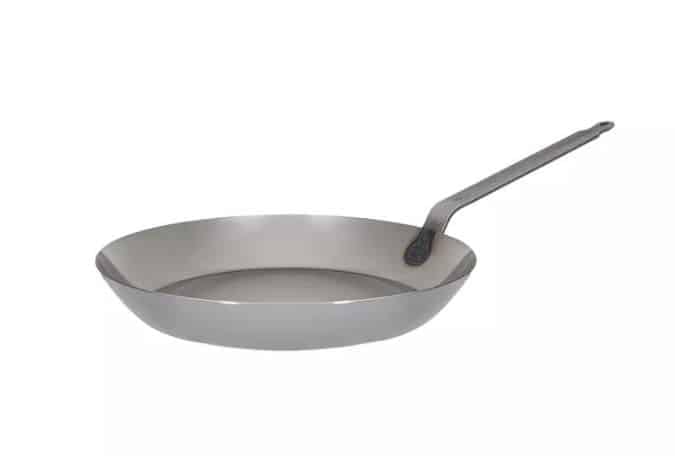
PROS
- Comes in a variety of sizes
- Distributes heat evenly without hot spots
- Welded handle allows for easy cleaning
CONS
- Requires effort to remove the beeswax coating
This versatile pan from Matfer Bourgeat is crafted in France and built for both professional kitchens and home cooks. It is made of unseasoned black carbon steel, so you will need to first remove the beeswax coating, which will be time-consuming and require some elbow grease, and then season it yourself.
Its steel handle is welded securely to the body—without rivets—making it easier to clean and preventing food or residue from getting trapped. We like the fact that this pan was lightweight compared to cast iron, and that it warmed up fast and even without hot spots. Chicken thighs would brown easily when seared, and eggs would not stick at all when the pan was well seasoned.
This pan was also quick to cool and we could easily control it when we were searing fish on high and then reduced the temperature to complete the cooking process. The only problems with sticking occurred when cooking foods containing sugar, which caused some caramelization and left residue.
The angled sides allow it to be used in many ways, stir-frying, sautéing, and you will be able to use it on virtually any cooking surface, including induction. Wash the pan with a bristle brush and a small amount of dish detergent to remove the protective coating before the first use.
Size: 10.4 inches | Weight: 3.9 pounds | Oven-Safe Temperature: Up to 400°F | Pre-Seasoned: No
4
Best Carbon Steel Wok Pan
Yosukata Carbon Steel Wok Pan
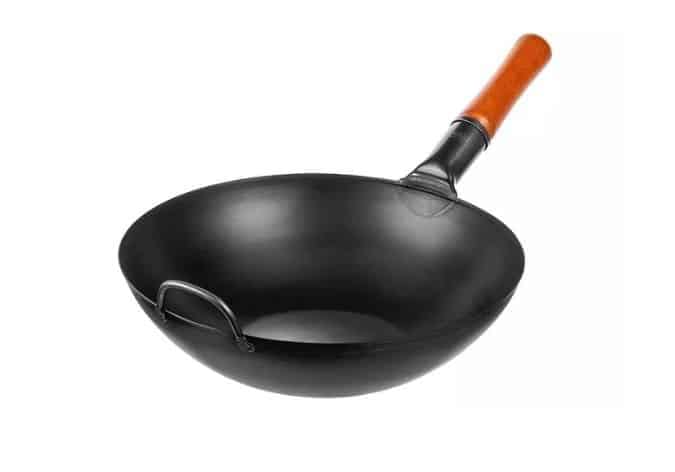
PROS
- Durable construction
- Easy to clean
- Large in size but not heavy
CONS
- Handle gets hot while cooking
This carbon steel wok has very little to dislike. It was unique in testing because it was easy to use, perform well, and clean up. Although the handles did become hot during cooking, this was a small inconvenience. Its strong construction impressed us particularly. The flat bottom ensures that it can fit any cooktop and it’s able to adjust to changes in cooking temperature.
We were surprised to find it very easy to manipulate and toss around, despite the 12-pound weight, when making beef fried rice. We didn’t need to scrub much after cooking, everything could be washed away with water. We re-seasoned it and it was now ready to be used again.
Size: 13.5 inches | Weight: 3.6 pounds | Oven-Safe Temperature: Up to 600°F | Pre-Seasoned: Yes
5
Best High Sides Carbon Steel Pan
De Buyer Mineral B Fry Pan
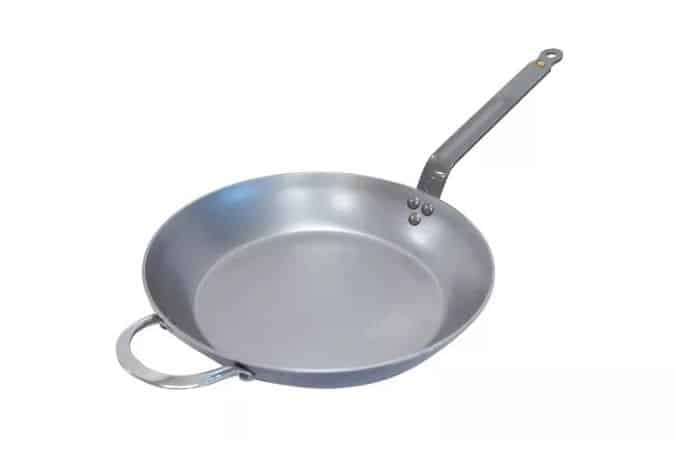
PROS
- Long handle remains cool to touch
- Helper handle provides easier control
- Performs well with both high and low heat
CONS
- Enamel-coated handle reduces oven compatibility
This pan sits at the border between a low-sided frying pan and a wok, with medium-high sides that will contain your food when you are stir-frying, but not take over storage space. This choice is produced in France and is covered with a coating of beeswax to shield the metal on its way to your door through the manufacturer.
The pan also features a long, comfortable handle that is firmly riveted to the body of the pan to allow you to toss the ingredients as you cook and to hang the pan comfortably when not in use. This pan was somewhat imbalanced and heavy out-of-the-box and we frequently needed to use both hands to hold the handle during cooking.
It boiled fast and in a most uniform manner, whether the fire was strong or weak. Most foods released easily, though we did encounter occasional sticking. Cleanup was simple, needing only a rinse with hot water.
One limitation is oven use. Because of the epoxy-coated handle, the pan is only safe in the oven for up to 20 minutes at 400°F. You want something that is fully ovenproof and can endure longer in the oven, the de Buyer Mineral B Pro, with a cast stainless steel handle, can be used.
Size: 12.5 inches | Weight: 6.34 pounds | Oven-Safe Temperature: Up to 400°F | Pre-Seasoned: Yes
6
Best Carbon Steel Crepe Pan
De Buyer Mineral B Crepe & Tortilla Pan
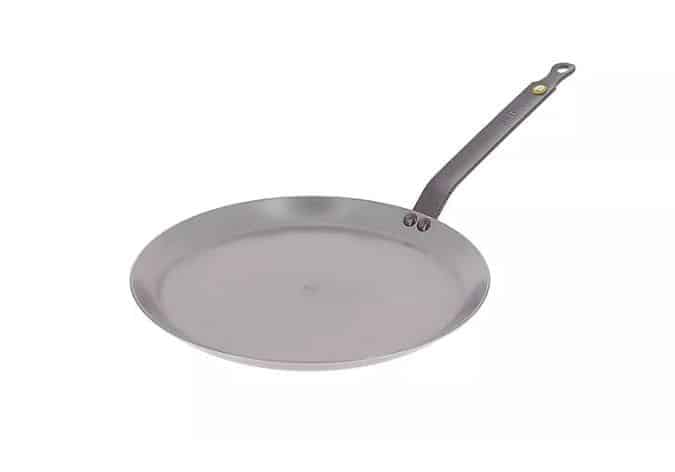
PROS
- Durable, well-built construction
- Handles are firmly riveted
- Best for crepes, omelettes, and pancakes
CONS
- Gets hot when the pan is used for long periods
Made in France by a well-known luxury cookware manufacturer, this crepe pan comes with an outer layer of beeswax, which needs to be removed before the pan is seasoned. After seasoning, it gets a fantastic non-sticky surface and provides even heat, thus using minimal oil to make crepes, pancakes and omelets.
In testing it, the pan was very quick to heat and had to be run on a lower burn than anticipated because the heat conductivity was almost too efficient. To achieve the best outcome use a medium flame and turn up or down as necessary, based on your crepe batter.
Although the sides on this pan are low and it can be easily accessed and turned into your crepes, it may be used to sear your proteins, prepare or heat tortillas and to cook whatever foods do not need the higher sides of either a skillet or a frying pan.
like the Mineral B fry pan of de Buyer, it has an epoxy-coated handle which gets hot, which restricts your use of the oven, but this is never a problem when you are doing stovetop cooking. There are three sizes: 9.5, 10.25, and 12 inches, hence you can pick the best diameter to fit your preferred crepe.
Size: 12 inches | Weight: 4.18 pounds | Oven-Safe Temperature: Up to 210°F | Pre-Seasoned: No
7
Best Carbon Steel Frying Pan
Lodge Seasoned Steel Skillet

PROS
- Comes in three versatile sizes
- Handles are solidly riveted for durability
- Heated fast and distributed heat evenly in testing
CONS
- Handle becomes hot during use
Lodge is most commonly recognized by its large collection of cast iron cooking equipment, but it comes as no surprise that the brand has made its way into carbon steel as well. Similar to its cast iron counterparts, this skillet comes pre-seasoned and is ready to cook as soon as it is taken out of the box, though further seasoning will enhance its ability to be non-sticky and increase its resistance to rust.
It surprised us how fast this pan would heat up and we were amazed by how responsive it was when we turned the heat up or down. One of the design problems, however, is that the handle becomes quite hot when cooking over long durations of time but this can be easily addressed by use of an oven mitt or pot holder.
It can be applied on any cook-top such as induction and also on a barbecue grill or a campfire. The skillet is available in three sizes; 8, 10 and 12 inches, which are also broiler-safe.
Size: 12 inches | Weight: 3.41 pounds | Oven-Safe Temperature: Not specified | Pre-Seasoned: Yes
8
Best Carbon Steel Pan for Eggs
KitchenAid Nitro Carbon Steel 10-Inch Skillet
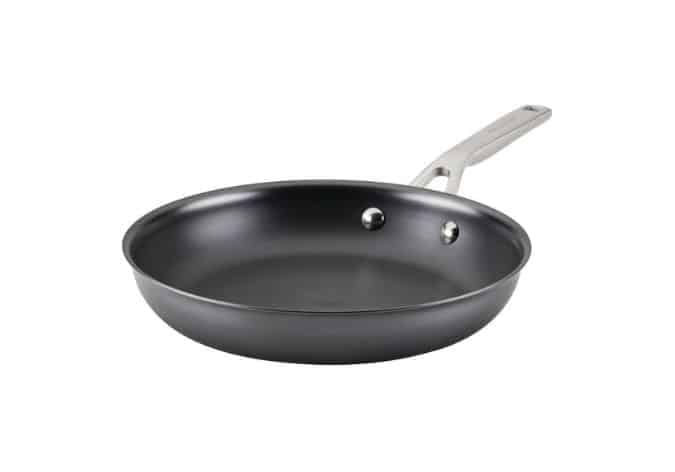
PROS
- Excellent performance with eggs
- Highly responsive to temperature changes
CONS
- Pan offers a compact cooking surface
KitchenAid, the most famous manufacturer of the legendary stand mixer, impressed us with its Nitro Carbon Steel line. Although the pans are not preseasoned, we found the suggested oven-seasoning technique simple and less difficult than the stovetop technique that many brands recommend.
This pan performed well in our egg tests, frying eggs with ease and leaving behind very little residue after scrambling- without the use of oil. It is very sensitive to heat and is therefore excellent in searing meats. This responsiveness however must be closely monitored to prevent food burning.
The pan is a little heavier than its size, but the comfortable, well-balanced handle makes it easy to handle. The cutout in the handle also enables easy hanging. Its highly rounded bottom is perfect to toss and stir the sauces, but it also minimizes the total cooking area.
Size: 10 inches | Weight: 2.7 pounds | Oven-Safe Temperature: Up to 750°F | Pre-Seasoned: No
9
Best Professional Carbon Steel Pan
BK 10-Inch Black Carbon Steel Frying Pan
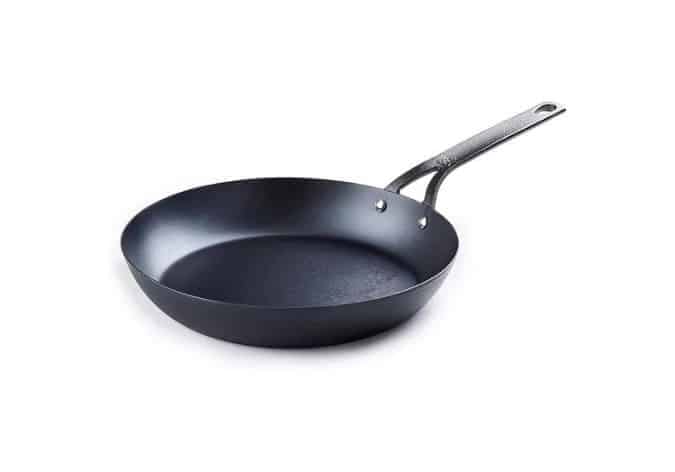
PROS
- Heats up fast
- Handle feels comfortable in hand
- Balanced design allows easy handling
CONS
- Cast-iron handle feels a bit heavy
In case you are not sure about investing in carbon steel, this inexpensive 12-inch skillet is a good place to begin. It is already pre-seasoned, so you can use it immediately after giving it a preliminary wash to remove the protective wax and it is a good size to sear a few small chops for dinner.
The handle is cast iron, and it is shaped in such a way that you can hold it comfortably in your hand as you cook even though it is heavy. Since the beginning of use the pan has been amazed with its non-stick functionality, balanced feel and the ability to flip the food.
It performed admirably in all experiments, such as frying eggs, and baking biscuits in a hot oven, where we expected to find them claggy–but found no such. At the price, it is a dependable, entry-level skillet that anyone who is trying carbon steel cookware can use.
Size: 10 inches | Weight: 3.3 pounds | Oven-Safe Temperature: Up to 660°F | Pre-Seasoned: Yes
10
Most Versatile Carbon Steel Pan
Merten & Storck Pre-Seasoned Carbon Steel Black Frying Pan
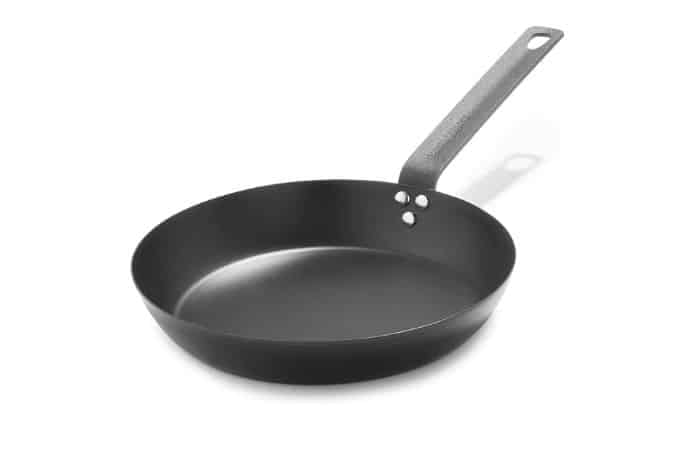
PROS
- Lightweight design with a spacious cooking surface
- Works well on grills and over open flames
CONS
- Handle lacks a loop for hanging
In our trials, this pan performed impressively. Our professionals like that it is already preseasoned, you only need to remove the protective glaze before you cook it the first time, and thus it is ready to use immediately. However, it was this pan’s performance that earned it the top spot: it’s lightweight and comfortable for most users, with gently sloped sides that provide ample cooking space and make shaking and tossing effortless.
The pan seared mushrooms perfectly, developing a deep, savory pan sauce. It had some difficulty with eggs, but it became better as we tried it more and more; we are sure a touch of oil would turn it into a fantastic choice regarding eggs, too.
It’s perfect to be cooked on the grill outside or even on the open fire. The absence of a loop on the handle is the only flaw, as it would be convenient to have an option of hanging storage.
Size: 10 inches | Weight: 2.64 pounds | Oven-Safe Temperature: Up to 600°F | Pre-Seasoned: Yes
What to look for when shopping the carbon steel cookware
Weight: Carbon steel pans are much lighter than cast iron pans of the same size, a 12 inch Lodge cast iron skillet weighs approximately eight pounds, whereas a 12 inch Lodge carbon steel pan weighs under five pounds. If moving heavy cast iron cookware in and out of storage feels cumbersome, carbon steel is an excellent alternative. A quality carbon steel pan offers enough weight to stay stable on the burner while remaining light enough to respond quickly to temperature changes.
Making: Carbon steel cookware usually begins as a sheet of metal which is then heated, pressed, and formed to the shape required. Pans are usually available in thickness of 2mm or 3mm, the latter being heavy and resembling a cast iron pan. In contrast to the single-piece construction of cast iron, handles are generally forged and then riveted on (as opposed to the ppt of this type of construction and spot-welded handles which are more prone to looseness or detachment with time). You will want to be sure that your handles are not too short or too long to reach into the stove or fit into the oven or to store away.
Heating Capacity: Like cast iron, carbon steel can withstand very high temperatures and works on a variety of cooktops, including induction and open flame. The maximum temperature of most carbon steel pans is 800°F, although there are those that can withstand temperatures of up to 1200°F. This is adequate enough to be used in daily stovetop and oven cooking, but other cooking methods such as wok cooking might require cookware that can withstand high temperatures. Carbon steel is also very sensitive to the temperature and it heats fast and cools fast when the heat is increased or decreased.
Maintenance: If you’re familiar with caring for cast iron, you’ll already know how to maintain carbon steel. Its tough surface withstands scratches and is safe to use with metal utensils, keeping maintenance simple. Similar to cast iron, carbon steel must not be washed using dish detergent or put in a dishwasher since it will strip away the seasoning. Wipe off any dirt, run under water and dry, and then heat a little oil in the pan until it begins to smoke. Use a paper towel to wipe the oil, and your pan is ready to be stored.
Frequently Asked Questions

What is cookable in a carbon steel pan?
Everything, including sautéed vegetables, seared meat, or baked goods such as cornbread or fruit crumble can be sautéed in a carbon steel skillet. They also have an opportunity to shallow-fry, cook fish and roast a whole chicken, as well. Long-simmered, acidic sauces are the only thing you should not cook in one, as they may eat the seasoning.
What is the way to clean a carbon steel skillet?
After your carbon steel skillet has established a good seasoning it is also very easy to wash, in most cases just a quick wipe with a paper towel will clean your skillet. The remaining layer of oil or fat is in fact beneficial to prevent rust on the surface. To make a hard cleanup, the hot water and scrub brush should be used, and the pan should be completely dry and coated with a thin layer of oil in order to prevent rusting. (Note: Following washing, the pan can be placed on a high burner to help dry off all the moisture then a little oil rubbed on the surface of the pan).
What causes carbon steel pan to change color?
Carbon steel turns color naturally during the cooking process and it is also self-seasoned with time. It is an entirely normal process – it is called patina. The patina keeps the skillet rust-free as well as developing a smooth, non-sticky surface that becomes better with every use.
What is the way to season a carbon steel pan?
The first step in seasoning a carbon steel pan is to remove any protective coating: most of them are shipped with a thin layer of beeswax to protect them. To remove the beeswax, De Buyer suggests using a soft cloth and hot water to take off as much of the beeswax as possible. After wiping the pan, and ensuring that it is clean and dry, a layer of oil or fat should be applied to the surface in a thin and even manner.
It can then either be put into the oven at 300F and allowed to cook within the oven (approximately an hour) or cooked on the stovetop in medium heat until the oil starts to bead. Only wipe off with a paper towel any excess oil. When you have a pan that is already seasoned, you will not need to do this step, although in some instances, you will be required to re-season, as this will preserve its performance and nonstick surface.
How many times do you re-season a carbon steel pan?
You will find that you will have to re-season your pan when there is any rust on it, or when your pan seems to be covered with old food deposits. Your pan will continue to accumulate seasoning with use, but should you ever wish to start again, scrub the surface with an abrasive sponge (or heat the pan a little then scrub with a mixture of salt and oil), and remove all the roughness, then begin the seasoning process again.
Is it possible to use a carbon steel pan on any cooktop?
Yes – carbon steel is very versatile and can be used on all cooktops, such as gas, electric and induction. It is also sturdy and can be used to cook outdoors, and thus it can be used in a campfire or a barbecue grill.
What is the difference between carbon steel and cast iron?
Cast iron and carbon steel are similar in several aspects in terms of durability and versatility; however, the most important distinction is the carbon content. Cast iron usually has 2 to 3.5 percent carbon and carbon steel has about 2 percent or less. This reduces its carbon content, which makes carbon steel more malleable, that is, it can be molded, hammered and stretched, but cast iron is more brittle and liable to cracking.
Due to its high iron content, carbon steel can be used with induction cooktops, and with time, its smooth surface forms a natural patina, which improves nonstick performance. The flexibility of its shape and lighter weight makes it suitable in pans with flared sides including skillets, saute pans, crepe pans, paella pans, and woks.

